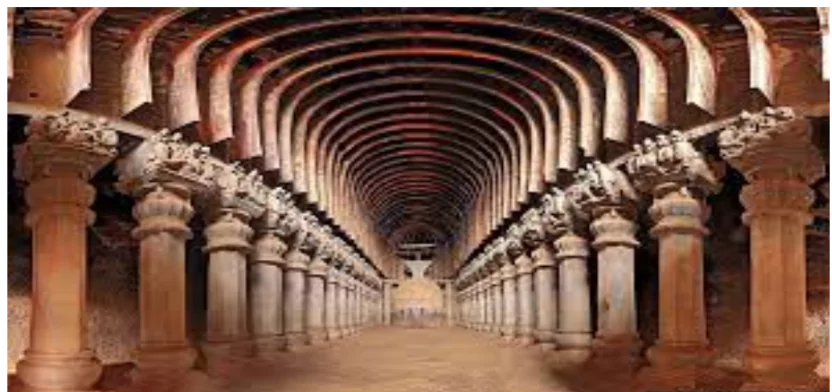Introduction

Post-Mauryan period witnessed the continuation and evolution of cave traditions in India, with caves serving as religious, artistic, and architectural expressions across various regions and dynasties.
Rock-Cut Caves
- This period saw the development of two types of caves:
- Chaityas
- Viharas [UPSC 2013]
- The caves were generally decorated with human and animal figures, they also had courtyards and stone screen walls.
| CHAITYAS |
VIHARAS |
- Used as prayer halls.
- These have a small rectangular doorway which opens to a vaulted Hall with an apsidal end .
- At the end, there is a stupa.
|
- Residential places for Buddhist and Jain monks.
- They consist of a main hall, assembly hall and dining chambers.
- From the halls deep into the rocks, cells are provided for meditation.
|
Enroll now for UPSC Online Course
Cave Tradition in Western India
- It hosts many Buddhist caves dating back to the 2nd century BC.
- Main Architectural Types:
- Apsidal vault-roof chaitya halls (found at Ajanta, Pitalkhora, Bhaja).
- Apsidal vault roof pillarless Hall (found at Thana-Nadsur in Maharashtra).
- Flat roofed quadrangular hall with a circular chamber at the back (found at Kondivite in Maharashtra).
- Important Sites of Rock-cut Caves: Vihara caves at Nashik, Ganeshleni at Junnar (Maharashtra), and Kanheri caves in Mumbai.

- In Karla, the biggest rock-cut chaitya hall was excavated & decorated with human and animal figures.
- Some of the important vihara caves are at Ajanta Caves, Bedsa Caves and Nashik Caves.
- The vihara caves at Nashik were excavated with front pillars carved with ghata-base and ghata-capital with human figures.
- Other Cave Sites: Bhaja Caves near Pune has Buddhist caves. [UPSC 2023], Kanheri in Mumbai
- Junnar has the largest cave excavations
- Vihara cave was also excavated at Junnar in Maharashtra, which is popularly known as Ganeshleni because an image of Ganesha belonging to a later period was installed in it.
Cave Tradition in Eastern India
Buddhist caves have been excavated mainly in the coastal regions of Andhra Pradesh and Odisha.
Guntupalli Cave (Andhra Pradesh)
- The caves were excavated in the second century BC. The cave is relatively small compared to the caves of western India.
- It is among the unique sites where structured stupas, viharas and caves are excavated in one place.
- It has circular chaitya cave and rectangular vihara caves
- Other Cave Sites in Andhra: Rampaerrampallam, Anakapalli and Dhanyakataka.
- Anakapalli in Visakhapatnam: A huge rock-cut stupa was carved out of the hillock during the fourth–fifth centuries AD.
- It is a unique site as it has the biggest rock-cut stupas in the country.
- Dhanyakataka (Andhra Pradesh): Prominent Buddhist center under the Mahasanghikas. [UPSC 2023]
- They have inscriptions of Kharavela Jain kings.
- According to the inscriptions, the caves were meant for Jain monks.
- The figures in this cave are voluminous, moving freely in the picture space.
- Some caves in this complex were excavated later, sometime in the eighth–ninth centuries AD.
- There are numerous single-cell excavations.
Enroll now for UPSC Online Classes
Conclusion
- The post-Mauryan era saw the proliferation of cave architecture, reflecting diverse cultural, religious, and artistic influences.
- These caves remain significant cultural landmarks, preserving the rich heritage of ancient India.
![]() June 7, 2024
June 7, 2024
![]() 3892
3892
![]() 0
0

